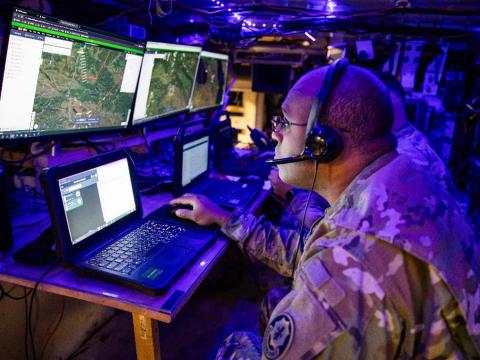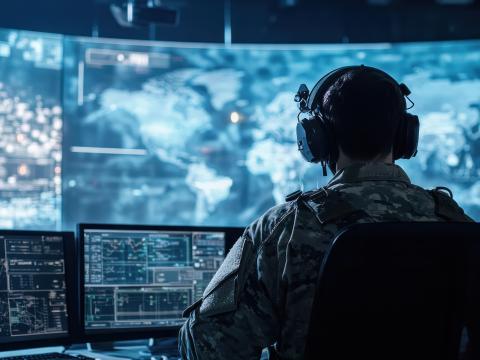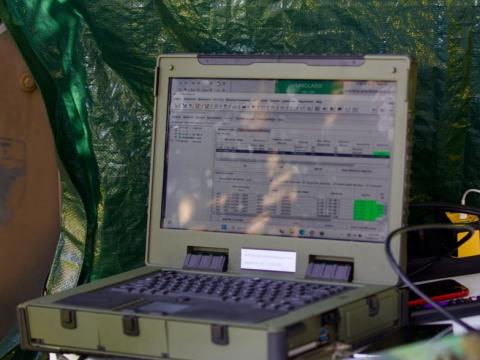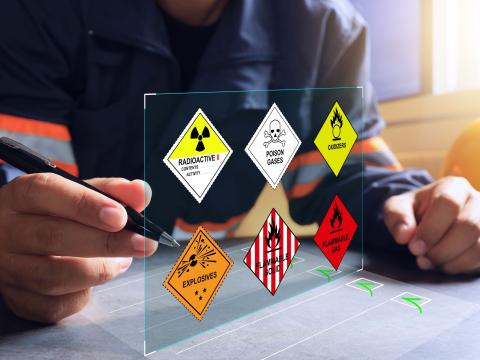U.S. Army Plays Catch-Up to Russian EW Operations
While Russia’s decades-long commitment and investment in the growing contested electromagnetic spectrum (EMS) domain has proven advantageous, the U.S. Army is bolstering its electromagnetic warfare (EW) efforts through reprioritization.
“When I started the Russia-Ukraine [electromagnetic warfare] lessons learned project, we didn’t have EW at basic trainings across the Army,” said Maj. Nelson Godbolt, senior instructor, U.S. Army Cyber School.
Godbolt spoke at the annual TechNet Augusta conference August 19, in Augusta, Georgia.
“The bottom line I think we all need to take away from the war is that EMS is going to be a contested domain,” he stated. “In all of our training and all of our future planning, we have to understand that EMS is not going to be uncontested.”
Godbolt began his remarks by outlining Russia’s sophisticated and strategic EMS planning through lessons learned from previous battlefields. Through the ‘90s, Russian soldiers maintained their EW complexes, he stated, and continued to modernize them from the Soviet era into the 2000s.
“They knew if they could deny us precision, if they could deny us over the horizon comms via [satellite communications], [high-frequency radio], all of a sudden, we couldn’t fight the way that we wanted to fight, and maybe they’d have a better chance at stalemate,” Godbolt said.
While the U.S. focus shifted to post-9/11 operations, Russia went on to maintain and upgrade its EW equipment. The circumstances and lack of resources therefore led to Russia’s advantageous 30-year investment into EW, while the U.S. lagged behind.
“They never got rid of their EW formations, and they did the exercises. They kept their doctrine, and they refined their doctrine,” Godbolt said of Russia’s military operations. Meanwhile, the U.S. Army is “just now getting equipment to our EW platoons,” with EW companies also on the way. Therefore, there have not been enough real-world examples of what the doctrine should look like, Godbolt shared.
“Where should the EW platoon be? What should it do? What about the EW companies that are coming? What are they going to receive? We just haven’t had the chance to go through and refine that,” he emphasized.
The current and ongoing war in Europe continues to serve as a lesson in which the Russian military has utilized its EW investment to fight their opponents.
The Russian battalion tactic groups on the front lines currently have about 300 pieces of equipment, Godbolt said.
“What this looks like is handheld, backpack, drone, defender kind of systems on the front lines, oftentimes paired with service member with a shotgun, so [we are] worried about one-way attack drones, primarily with those systems,” he continued. “If you go out of direct-fire range, you’ll find these cheap systems that are always on, and they’re just going after one-way attack drones, either their GPS or they’re going after [command and control] links.”
In addition to that, Godbolt listed exquisite systems owned by the Russian military, such as counter-radar, long-range counter-positioning, navigation and timing, and counter-synthetic aperture radar systems. This emphasizes the combination of kinetic and non-kinetic war, he highlighted.
In all of our training and all of our future planning, we have to understand that EMS is not going to be uncontested.
“We found out that what the Russians advertised the last two decades of arms sales wasn’t a lie,” Godbolt stressed. “They could find and they could jam U.S. comms … this shouldn’t be a surprise.” With any known capability, the adversary will invest in defeating it, he said.
What the Ukrainian military succeeded in was adaptation. By turning off cellphones and avoiding the use of their military radios, the Ukrainians adapted in EMS at the tactical level in response to their adversary’s use of EW.
The Ukrainian military has also used low-Earth-orbit satellites for communications.
“This doesn’t mean that this is going to be a future solution against EW in the next conflict,” Godbolt pointed out. “What this means is if you have a technological innovation that hasn’t been used before, that’ll give you an advantage.”
Godbolt also highlighted the importance of noting the signals being emitted and those being received, as both could lead to becoming a target.
As lessons continue to be learned from the Ukraine-Russia conflict, the U.S. Army’s reprioritization of EW is key for a future fight. Godbolt called for further expansion in logistics, training and more.
“This gives me hope that the Army gets the problem set,” he said. “We’re in a resource-constrained Army right now. Budgets are not expanding, but the Army is investing in increased [command and control] because it gets that our legacy systems that have been out there for decades, our adversaries invested against them. It sees that in Russia and Ukraine and understands that it has to invest it, or else the same thing that the Russians and Ukrainians are doing to each other could be done to us.”
TechNet Augusta is organized by AFCEA International with help from the U.S. Army Cyber Center of Excellence. SIGNAL Media is the official media of AFCEA International.




Comments